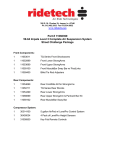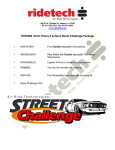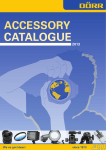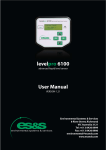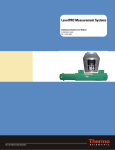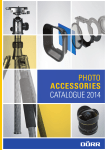Download R-Tech I-CUT100P Installation guide
Transcript
Installation Guide & Operation Manual Thank you for choosing a RideTech air suspension control system. We are committed to providing the best experience possible throughout the process of getting your car on air. Our commitment doesn’t end with your purchase, in fact, it has only begun. This guide should provide you with the information you need to properly install and set-up your suspension control system. However, if you find yourself having difficulty or if you have a question that isn’t covered in this book, please call our tech department. Tech Line: 812-481-4969 In addition to phone support, our web site also provides a wealth of helpful product / install / set-up information. Contents Quick Start..................................................................... 2 Wiring Diagrams............................................back cover AirPod™ Installation Mounting the unit.................................................................3 Wiring.........................................................................................3 Component Installation Mounting compressor.........................................................4 Mounting tank........................................................................4 Mounting air valves..............................................................4 Routing air lines & fittings..................................................5 Mounting pressure sensors................................................5 Mounting the controls & ECU............................................5 Wiring.........................................................................................5 LevelPRO Installation Installing external ride height sensors...........................6 Installing internal ride height sensors............................6 Sensor Rod Assembly...........................................................7 Example installations...........................................................7 Operation & Controls Button description................................................................8 Setting presets........................................................................8 Selecting presets....................................................................8 Tank button..............................................................................8 Menu Activating / navigating menu...........................................9 Menu structure.......................................................................9 Menu functions.............................................................10-11 Quick Start Press 3 to start setup. 0 Setup Required 0 0 0 Tank: 0 Calibration: During the Calibration sequence the e3 records information specific to the vehicle in which it is installed (inflate and deflate speed, if level sensors are present, how long the compressors take to fill the storage tank, etc.) The e3 then uses this information to attain the proper preset heights in the fewest possible steps, using the most intelligent method. For example, after calibration the e3 knows that the front of the vehicle is heavier and therefore slower than the rear, so it will inflate the front first then allow the rear to catch up just as the vehicle is achieving ride height. Calibration Steps: (items in red require user interface, other steps are automatically completed) 1. 2. 3. 4. 5. 6. 7. 8. Releasing all air - this provides a solid starting point for the Calibration sequence Locating tank pressure sensor - locates and checks the tank sensor Locating air spring pressure sensors - locates and checks the air spring pressure sensors User must raise to Max, then press and hold Preset #3 - sets the upper limit of suspension travel Locates level sensors (if present) - level sensors will be automatically displayed if present Determines suspension type - different suspension types will utilize different software to achieve preset heights User must set Preset #2 - allows the user to set the Ride Height Check vehicle speed to and from Preset #2 - the e3 will utilize this information to achieve Ride Height in the fewest possible steps using the most intelligent method 9. Determines how much air pressure is required to slightly lift the vehicle - this information allows the e3 to more efficiently manage air usage 10.Determines vehicle speed from lowered height to Preset #2 - the e3 will utilize this information to achieve Ride Height in the fewest possible steps using the most intelligent method 11.Deflates down to Preset #1 - tests the system for deflating to Preset #1 12.Uses Calibration data to travel to Preset #2 - tests the system for inflating to Preset #2 13.Calibration complete Skipping the Calibration: Upon initial installation the E3 requests that you perform the Calibration Sequence. The Calibration does not need to be run upon initial installation. If the vehicle is still in the build stages you can postpone Calibration until the vehicle is complete. You still have full manual control of each air spring and the pressure readings from each air spring are displayed on the screen. However, until the Calibration Sequence has been completed your preset functionality will not perform properly. Systems covered in this manual: This guide covers installation of all RidePRO e3®, LevelPRO™ and AirPod™ systems. It is important to know what system you are installing and what sections pertain to your application. Check below to ensure you understand your system’s configuration. airpod TM Part # ARC4000L ARC4100L ARC4700L ARC4800L LEV8000 LEV8500 LevelPRO™ systems use level sensors & air pressure sensors LevelPro 4 way system / 3 gal. Tank LevelPro 4 way w/dual comp. / 5 gal. Tank LevelPro BIG RED 4 way / 5 gal. Tank LevelPro BIG RED MAX / two 5 gal. Tanks LevelPro electronics package LevelPro upgrade for RidePro E3 Part # ARC4000e3 ARC4100e3 ARC4700e3 ARC4800e3 RidePROe3® systems use pressure sensors only RidePro e3 4 way system / 3 gal. Tank RidePro e3 4 way /dual comp. / 5 gal. Tank RidePro e3 BIG RED 4 way / 5 gal. Tank RidePro e3 BIG RED / two 5 gal. Tanks AirPod™ electronics & controls are identical to LevelPRO™ and RidePRO e3® systems Part # airpod APOD4100L 5 gal. Tank, 2 comp. LevelPro TM APOD4000L 3 gal. Tank, single comp. LevelPro APOD4100e3 5 gal. Tank, 2 comp. RidePro e3 APOD4000e3 3 gal. Tank, single comp. RidePro e3 airpod TM LevelPRO™ and RidePRO e3® Systems differ only in the addition of the ride height sensors. 2 Installing an AirPod AirPod Part #: APOD4000L APOD4000e3 APOD4100L APOD4100e3 STOP Remove the negative battery cable before beginning installation. MOUNT THE MAIN UNIT: 1- Mount the base flat to the vehicle surface (do not bend the base) 2- Secure the base with self tapping screws or bolts. 3 - Secure the cover to the airpod base using the supplied screws. CONNECT AIR LINES: 1 - Airline cuts must be straight and clean - use a razor blade or tubing cutter. (part # - cut1000) 2 - All fittings are DOT approved, reusable, push-to-connect style. Firmly push the airline into the fitting to attach. To release the airline push the collar on the fitting back towards the fitting and pull the airline out. 3 - All of our airlines are DOT approved so they are very strong. Secure the airline with zip ties, keep them away from any sharp edges and when passing through a hole in the frame use a grommet. 4 - Keep away from intense heat including mufflers and exhaust manifolds. CONNECT POWER HARNESS: 1 - Connect the red power wire directly to the battery. Be sure to use included fuse Use included fuse within 18” of battery. 2 - Connect the yellow ignition wire to switched 12v. 3 - Connect the black wire to chassis ground. CAUTION: Use 10 gauge wire or larger to extend red power feed if needed holder in the battery feed wire as close to the battery as possible. POWER - RED SWITCHED- YELLOW GROUND - BLACK CONNECT LEVELPRO SENSORS (if equipped): See LevelPRO section for more information on installing and calibrating height sensors. CONNECT DISPLAY / CONTROLS: See control programming and additional features section for more information on using the control panel. 3 Installing a RidePRO e3 System RidePRO e3 Part #: ARC4000e3 • ARC4100e3 • ARC4700e3 • ARC4800e3 LevelPRO Part #: ARC4000L • ARC4100L • ARC4700L • ARC4800L STOP Remove the negative battery cable before beginning installation. Mounting the Compressor Mounting the Air Tank • All of our compressors are sealed for moisture and dust resistance so they can be mounted anywhere on the vehicle. Although it is best to mount it in a place out of direct contact with rain and snow. It is OK to mount it underneath the vehicle but keep it inside the frame rails away from water and debris thrown off the tire. • The air tank can be mounted anywhere on the vehicle in any position. (sensor cannot be on bottom) • There is an 1/8” port in the tank that will accept the tank pressure sensor. • This is a dry compressor; therefore it is maintenance free and can be mounted in any position. • It is best if mounted to something solid to reduce vibration and noise. If mounting it to sheet metal or the bed of a truck use sound deadening material between the compressor and Filter / muffler the mounting surface. install on inlet • Use the rubber grommets supplied on the feet of the compressor to reduce vibration. • Attach the grey wire from the main power harness to the black wire on the primary compressor. The red wire connects to +12V Use spacer for better cooling Mounting the RidePro Air Valves Always use rubber mounts • If using two compressors, an additional harness will attach to the main power harness (part #WIR8162). Attach the blue wire from this harness to the black wire on the second compressor and the second compressor red wire to +12V. • If you are running two compressors you will need an additional harness. • Thomas Compressors (black) will require a 20 amp fuse (each). • Viair Compressor (silver) will require a 30 amp fuse (each). NOTE: The e3 system switched ground on the compressors, the compressors are provided power at all times. 4 Tank pressure sensor • The valves, like the compressor, are sealed and can be mounted in the same locations. Although if the vehicle will be exposed to freezing temperatures it is a good idea to mount them in the engine bay if possible to reduce the possibility of freezing. • They can be mounted in any position. • Attach the ground strap to a good, clean ground (preferably the frame). Ensure a good ground is used • The exhaust port will be left open. • The valve is held closed with the pressure in the tank. If tank pressure drops below air spring pressure they will equalize, deflating all 4 air springs. Routing the Airline and Fittings Mounting the Air Pressure & Level Sensors • Make all airline cuts with a razor or tubing cutter (part # - cut1000). It must be clean and straight or it will not seal. • These sensors are voltage based and do not need to be grounded. Use Tubing Cutter (part # CUT1000) for straight ends. • Use thread sealant when installing pressure sensors in valve block. • All fittings are DOT approved pushto-connect style. They are very simple to use and are reusable. Firmly push the airline into the fitting to attach. To release the airline push the collar on the fitting back towards the fitting and pull the airline out. • Use thread sealant on all fittings. • Do not over tighten the fittings. This could result in breaking the fitting or damaging the air spring. use thread sealant to avoid leaks • All of our airlines are DOT approved so they are very strong. But keep them away from any sharp edges. Also when passing through a hole in the frame use a grommet. • Keep away from intense heat including mufflers and exhaust manifolds. • Use zip ties or other fasteners to secure the airline. Mounting the ECU (Electronic Control Unit) & Control Panel • The ECU is water proof and may be mounted in the engine bay or under the vehicle. • The control panel should be accessible from the drivers seat and may be mounted or left unmounted. • The control panel cable uses mini USB connectors. Extensions can usually be found locally or purchased from RideTech. Valve Connector Power/Relay Connector Air Pressure Harness Connector 0.460 3.816 3.816 0.4602.477 Main Power Harness 2.477 Black wire A clean chassis ground Yellow wire Ignition 1.723 (12 volts only when the key is on) Red wire Constant 12 volt 1.723 5.050 6.461 Display Connector 6.461 Height Sensor Harnesses Right Front Level Sensor Connector Left Front Level Sensor Connector Right Rear Level Sensor Connector Left Rear Level Sensor Connector 5.050 Pressure Harness Display / Controller Harness Valve Block Harness Main Power /Compressor Harness 5 Ride Height Sensors External LevelPRO Sensor Installation • T he LevelPro system uses 4 height sensors (one at each wheel). They are weather proof and may be mounted in any position as well as “clocked” in any position. (There is not a difference between the left and right sensors.) These sensors are typically mounted to the chassis / frame rail. • A linkage with rubber ends connects the sensor arm and a suspension component. On most front suspensions the linkage will attach to the upper or lower control arm. On most rear suspensions it will attach to the axle or control arm. Attach to suspension • T he main goal when mounting the sensor is to achieve as much sensor rotation as possible without exceeding the sensors limits. • A lthough the sensor arm will rotate 180 degrees, it must remain in the middle 90 degrees throughout suspension travel. See diagram below for sensor travel limits. • I t may be necessary to shorten the sensor arm and drill a new hole to ensure the arm is rotating enough during suspension travel to accurately determine vehicle height. • T he sensor arm can also be removed from the sensor and clocked in four different positions. It may also be necessary to bend the sensor arm and/or linkage to achieve proper clearance and alignment. • T he sensor will be mounted to the frame using ¼” self tapping screws or bolts. A special shouldered bolt is supplied to attach the rubber rod ends to the suspension and the sensor arm, this will avoid over tightening. • M ake sure the sensor has adequate clearance from all suspension components throughout suspension travel. Check tire clearance, lock to lock and throughout suspension travel. Attach to Chassis 90º of effective range Travel Limits TOO FAR Good Good ✔ ✔ Internal LevelPRO Sensor Installation Use of internal ride height sensors requires no special installation. Simply plug the ride height sensor harness into the ShockWave. The Internal ride height sensor is a state of the art infrared leveling sensor and works by bouncing an infrared light beam off the shock inside the Shockwave® unit. This signal tells the distance between to the two, and knows exact ride height every time! The Internal ride height sensor is built to surpass O.E.M. specifications. 6 ✖ ! If the electrical range of travel is exceeded the system may function erratically or not at all. ! Also note that if the sensor has very little travel the LevelPro system may not perform to its potential. ! It may be necessary to shorten the sensor arm to increase travel. Ride Height Sensors Assembly of the LevelPRO Sensor Link Rods 1- Once the linkage rod has been cut to the proper length assemble the linkage rod with heat shrink tubing and the rubber end. 2- Slide the heat shrink tubing over the rubber end as far as it will go. 4- Continue shrinking the tube to the rod until secured. Be sure not to overheat the tubing causing it to pull from the rubber end. 5- Once both sides of the linkage have been finished secure the linkage to the sensor and suspension. 3- Heat the shrink tubing with a heat gun (hair dryer or small torch will work). Begin by heating the rubber end first. The heat shrink is lined with adhesive and will stick to the rubber when heat is applied. Sensor Mounting Examples 69 Camaro Front Rear Trailing Arm 58-64 Impala Front 65-70 Mustang Rear Triangulated 4-Link Rear C-10 Truck Rear 7 Basic Operation & Controls Tank Pressure Left Front Level Sensor Position Right Front Level Sensor Position Menu Button Left Front Air Pressure INFLATE & DEFLATE BUTTONS Right Front Air Pressure Left Front Inflate Right Front Inflate Left Front Deflate 99 PSI 50 Left Rear Inflate PSI 99 You have full manual control at any time. To inflate an air spring simply press and hold the corresponding “+” button. To deflate an air spring simply press and hold the corresponding “-” button. The corresponding air spring will be inflated OR deflated until the button is released. Right Front Deflate PSI 50 PSI Left Rear Deflate 99 99 50 50 PSI Right Rear Inflate PSI PSI PSI Right Rear Deflate Error Warning Preset #1 Preset #2 Preset #3 Indicator Left Rear Air Pressure Left Rear Right Rear Level Sensor Level Sensor Position Position Right Rear Air Pressure PRESET BUTTONS There are three preset buttons located on the lower portion of the display. These can be learned to any height, but normally they are set as: =Deflated Setting =Ride Height SETTING PRESETS Use inflate and deflate buttons to obtain desired vehicle height. To store the height as a preset press and hold the preset button for 5 seconds or more. The screen will display “Preset is saved” when completed =Inflated Setting 99 99 50 50 99 99 50 50 PSI Preset 2 saved PSI PSI PSI Press and hold for over 4.5 seconds to store current ride height as a preset SELECTING PRESETS To select a preset press and hold the preset button for a half-second and no longer than 5 seconds. (The delay is required to minimize accidental activation of presets.) The screen will display “Preset selected” when activated. PSI PSI Preset 2 selected PSI TANK BUTTON TANK PRESSURE: 139 PSI Press TANK to exit. 8 PSI Tank pressure can be viewed at any time by pressing the The tank pressure will be displayed until the button. button is pressed again. Press preset for 0.5 second to activate preset Menu Options The main menu is used to change system parameters, such as increasing the brightness of the screen, or the menu is used to access system information, such as viewing your preset pressures and level sensor settings. Main Menu Auto Leveling OFF Dynamic Leveling Display Options System Setup Wireless Remote UP SELECT DOWN To enter the Main Menu simply press the button. Once in the menu you can scroll up using the button, scroll down using the button, or select a menu item by pressing the button. You may go back a screen by scrolling to the bottom of each page and selecting the “BACK” button, or by pressing the button. MENU STRUCTURE MAIN MENU AUTO LEVEL ON OFF DYNAMIC LEVELING ON OFF DISPLAY OPTIONS TIME OUT FEATURE OFF 30 SECONDS 60 SECONDS 120 SECONDS 300 SECONDS BACK AUTO LOW INTENSITY MID INTENSITY MAX INTENSITY BACK AUTO LOW INTENSITY MID INTENSITY MAX INTENSITY BACK ON OFF SCREEN INTENSITY KEYPAD INTENSITY ALERT NOTIFICATION BACK SYSTEM SETUP COMPRESSOR ON PSI TURN ON PRESSURE BACK HIGH BACK SYSTEM ACCURACY STANDARD MEDIUM PRESET SETTINGS ON PRESET LOCKOUT OFF VIEW PRESET 1 L. FRONT PSI/VOLTAGE R. FRONT PSI/VOLTAGE L. REAR PSI/VOLTAGE R. REAR PSI/VOLTAGE BACK R. FRONT PSI/VOLTAGE L. REAR PSI/VOLTAGE R. REAR PSI/VOLTAGE BACK R. FRONT PSI/VOLTAGE L. REAR PSI/VOLTAGE R. REAR PSI/VOLTAGE BACK VIEW PRESET 2 L. FRONT PSI/VOLTAGE VIEW PRESET 3 L. FRONT PSI/VOLTAGE BACK RERUN SETUP ARE YOU SURE YOU WANT TO RERUN SETUP? NO YES BACKUP ECU RESTORE ECU SYSTEM INFO DISPLAY SW VERSION ECU SW VERSION VOLTS BACK BACK WIRELESS REMOTE LEARN KEYFOBS PRESS BUTTON 1 ON EACH KEYFOB YOU WANT TO USE KEYFOBS FOUND=___ DOUBLE PRESET TROUBLESHOOTING 0 1 ON 2 BACK 3 OFF BACK ADVANCED OPTIONS EXIT MENU 9 Menu Options - Details AUTO LEVEL DYNAMIC LEVELING: The Auto Level on Start feature is used to raise the vehicle to the #2 Preset each Dynamic Leveling will automatically raise or lower the vehicle back to the #2 Preset if the load changes while the vehicle is parked. As soon as the vehicle is in motion the system stops adjusting as it’s unsafe to alter air spring pressure while driving. ON: The vehicle will return to the #2 Preset if the load changes. time the ignition is turned on. ON: When vehicle is started it will return to the #2 Preset. OFF: When vehicle is started it will not automatically adjust to any setting OFF: The vehicle will not adjust if the load changes. DISPLAY OPTIONS Display Options allows you to change items such as the brightness of the screen or buttons as well as how long the screen will remain illuminated. OPTIONS TIME OUT FEATURE: The display screen and button backlights can remain illuminated at all times, or if you wish they can turn off after some time. OFF: The display will remain on as long as the ignition is on. 30 SECONDS: The display will remain illuminated for 30 seconds. 60 SECONDS: The display will remain illuminated for 1 minute. 120 SECONDS: The display will remain illuminated for 2 minutes. 300 SECONDS: The display will remain illuminated for 5 minutes. KEYPAD INTENSITY: The intensity of the button backlighting can be automatically adjusted depending on ambient light conditions, or it can be changed to 3 intensity levels. AUTO: The backlight intensity will change with ambient light conditions. LOW INTENSITY: The backlighting will remain at the lowest intensity. MID INTENSITY: The backlighting will remain at a medium intensity. MAX INTENSITY: The backlighting will remain at the brightest setting SCREEN INTENSITY: The intensity of the display screen backlighting can be automatically adjusted depending on ambient light conditions, or it can be changed to 3 intensity levels. AUTO: The backlight intensity will change with ambient light conditions. LOW INTENSITY: The backlighting will remain at the lowest intensity. MID INTENSITY: The backlighting will remain at a medium intensity. MAX INTENSITY: The backlighting will remain at the brightest setting. SYSTEM SETUP System Setup allows you to change items such as system accuracy and compressor turn on pressure. You can also view system information such as preset settings and software revision. COMPRESSOR ON PSI: The compressors can be configured to turn on anytime the pressure drops below 125 to 140psi. Setting the turn on pressure higher will make the compressors run more often, but for a shorter length of time. Setting the turn on pressure lower will make the compressors run less often, but they will run for a longer amount of time. SYSTEM ACCURACY: The System Accuracy feature allows the user to choose how precise the system is when attempting to reach a preset destination. This feature satisfies all drivers (some like to wait for the system to reach preset before driving away while others want to start the car, throw it in drive and take off ) STANDARD: The vehicle will reach the preset destination in as few operations as possible. This is acceptable for most applications. MEDIUM: The system will be slightly more precise than the Standard setting which means it will take a few more steps to reach a more precise target. HIGH: This is the most accurate the system can be. It will take longer to reach the preset destination, but you can be assured that the vehicle is at the exact preset height. PRESET SETTINGS: Should you ever need to know the values that are saved for the three preset settings they can be accessed here. If you are using an air only system you will only see pressure readings for each air spring. If you are using an air and level sensor system you will see both air pressure readings as well as level sensor voltage readings. 10 RERUN SETUP: Should you ever need to recalibrate the system you may do so by rerunning the setup procedure. When you choose to rerun the setup you will be asked: “ARE YOU SURE YOU WANT TO RERUN SETUP?” You may select YES by pressing the “1” button, or select NO by pressing the “3” button. BACKUP ECU: Upon initial installation the E3 system had you go through a calibration exercise. This calibration saved information about your vehicle such as how quickly the vehicle inflates and deflates, how often the compressors run, etc. Should you ever need to change ECU’s you can back up the calibration data from the ECU to the display so you don’t have to go through calibration again. RESTORE ECU: Once you have saved the calibration data using the “Backup ECU” feature you can use the Restore ECU feature to load a new ECU with calibration data from the old ECU. SYSTEM INFO: This is where you find the software revision of both the display and ECU as well as a volt meter to aid in troubleshooting. DISPLAY SWVER: This is the software version that is loaded into the display. ECU SW VER: This is the software version that is loaded into the ECU. VOLTS: This is a digital voltmeter that will show you the voltage of the vehicle. Menu Options - Details WIRELESS REMOTE LEARN KEYFOBS The E3 system has the capability of learning up to 4 remote keyfobs. Learning new keyfobs is as simple as pressing the #1 button on each keyfob, one at a time, until all keyfobs are learned into the system. Each new keyfob will be recognized by the E3 system and the corresponding number will be displayed on the screen. DOUBLE PRESET: If this feature is ON you will have to press the desired preset button on the keyfob twice in succession before the vehicle will travel to the desired preset. This feature is intended to minimize accidental triggering of a preset. TROUBLE SHOOTING The E3 system keeps a log of each error message that has been triggered. You may enter the Troubleshooting area of the menu for assistance in resolving any error. (errors are indicated by a ! on the main screen) Simply select the error you wish to resolve and the E3 system will walk you through the same steps our tech support staff uses to help you resolve the issue. ADVANCED OPTIONS The Advanced Options menu is a place where we keep tools and utilities to assist our staff in setting up or troubleshooting any area of the E3. The Advanced Options menu is accessible only with a pass code. 11 Wiring Diagram MENU TANK + + - - + + - Shown with 1 2 3 upgrade PINK Storage Tank YELLOW SWITCHED +12VDC (IGNITION) RED +12VDC BROWN - RF GREEN - LF YELLOW - RR WHITE - LR BLACK-TO CHASSIS OR BATTERY GROUND BLUE +12VDC GREY Primary Compressor Air Pressure Sensors B AT TE R RED BLACK LRD RRD LFD RFD LRU RRU LFU RFU +12VDC Secondary Compressor RED BLACK Air Distribution Block Rear: Blue - Left Inflate Black - Right Inflate Pink - Left Deflate Orange - Right Deflate Front: Green Yellow Brown Grey - Left Inflate - Right Inflate - Left Deflate - Right Deflate 350 S. St. Charles St. •Jasper, IN 47546 • 812-481-4969 12 Y













